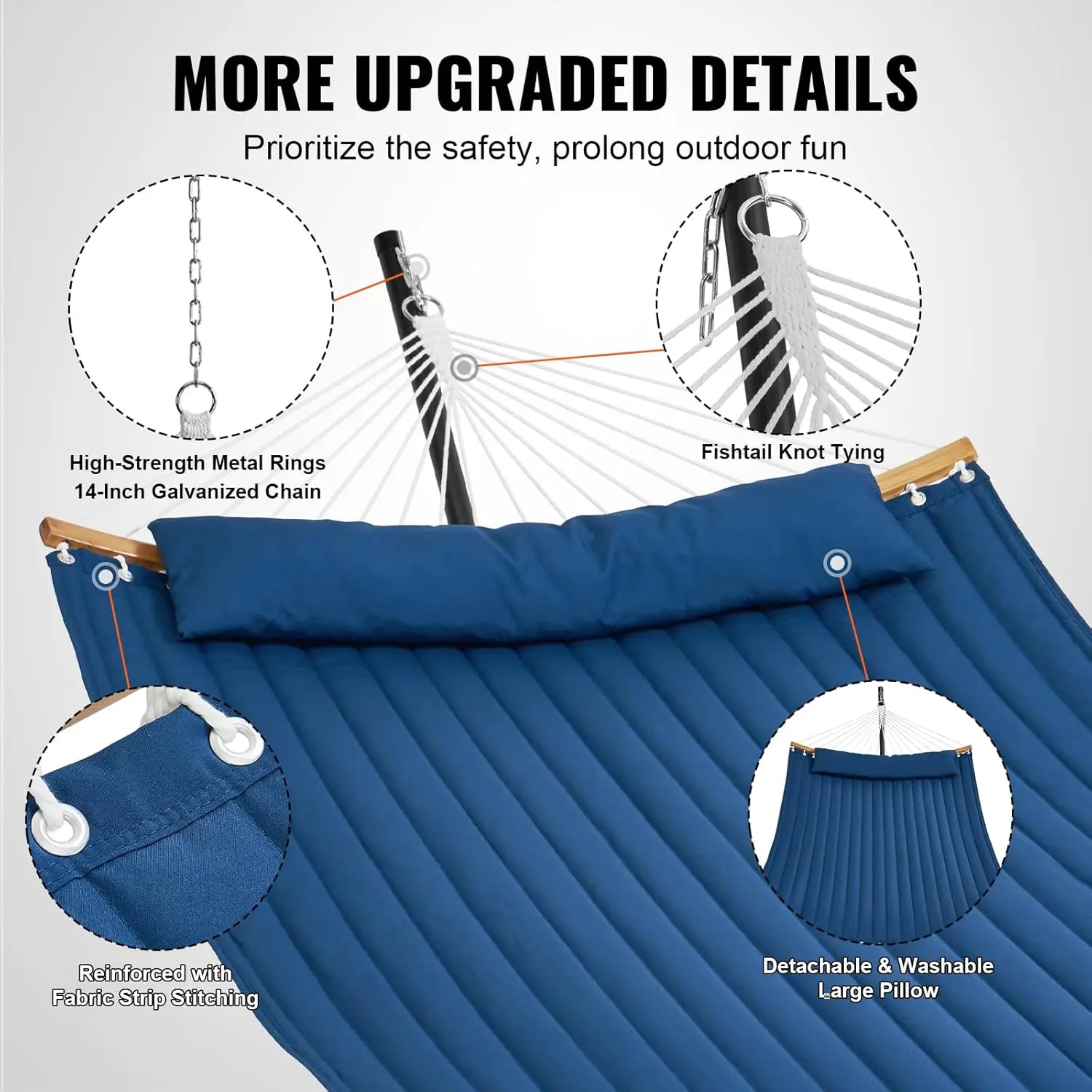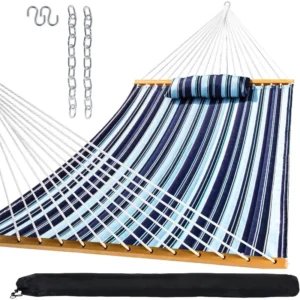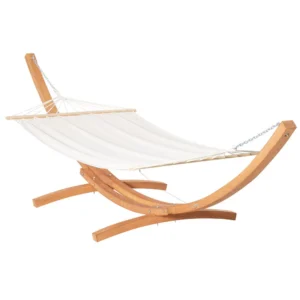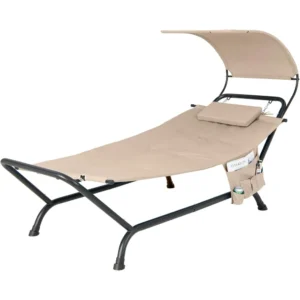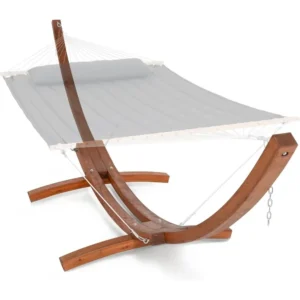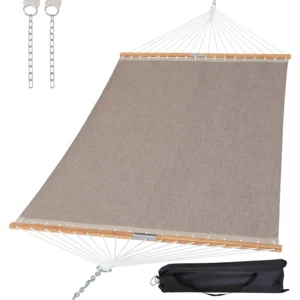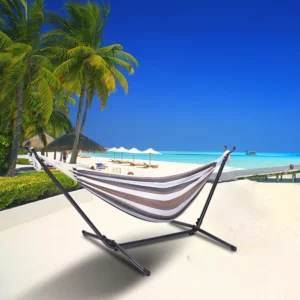Understanding Quilted Hammocks and Their Fabric Requirements
Quilted hammocks represent the pinnacle of hammock comfort through their distinctive layered construction. Unlike traditional rope or single-layer fabric hammocks, quilted versions feature multiple fabric layers with soft batting or filling sandwiched between them. This construction creates a padded, insulated surface that’s held together by decorative stitching patterns that prevent the filling from shifting.
The fabric selection for these hammocks isn’t just about aesthetics—it’s fundamentally tied to the hammock’s performance. The right fabric must simultaneously support body weight, hold multiple layers together, and distribute pressure evenly across the quilting pattern. Too thin a fabric will stretch and potentially tear under the combined weight of the user and batting material, while overly rigid fabrics might create uncomfortable pressure points.
When selecting fabric for quilted hammocks, understanding how it interacts with the inner filling is crucial. The outer fabric needs sufficient strength to contain the batting while still allowing the quilting to create the characteristic soft, cushioned surface that makes these hammocks so desirable. Proper indoor-outdoor hammock placement considerations should inform your fabric selection, as location significantly impacts which materials will perform best.
Essential Factors for Selecting Quilted Hammock Fabrics
When evaluating fabrics for your quilted hammock, several critical factors determine whether your selection will provide years of comfortable relaxation or premature disappointment. The ideal fabric strikes a delicate balance between durability, comfort, weather resistance, and cost.
Your hammock’s intended environment plays a decisive role in fabric selection. Indoor hammocks can prioritize softness and aesthetic appeal, while outdoor hammocks must withstand UV exposure, moisture, and temperature fluctuations. Considering whether it’s okay to leave your hammock outside will help determine how weather-resistant your fabric needs to be.
Key considerations include:
- Tensile strength and weight capacity
- UV resistance for outdoor use
- Moisture-wicking and drying properties
- Breathability for comfort in hot weather
- Softness against skin
- Resistance to mold and mildew
- Colorfastness and fade resistance
- Ease of cleaning and maintenance
These factors don’t exist in isolation—they interact with each other and with your specific usage needs. A hammock for a covered porch has different requirements than one for full sun exposure beside a pool or beach.
Durability and Strength: Foundation of Quality Hammock Fabric
The structural integrity of your quilted hammock depends primarily on its fabric strength. Quality hammock fabrics must deliver consistent performance across several strength metrics to ensure safety and longevity.
Tensile strength—the fabric’s resistance to tearing when pulled—represents the most critical factor. A quilted hammock supporting an adult typically needs fabric that can withstand at least 300-400 pounds of force without stretching excessively. This requirement increases for double hammocks intended for two people.
Equally important is tear resistance, which measures how easily a fabric will continue to tear once a small tear or puncture occurs. Strong quilted hammocks utilize fabrics with high tear resistance to prevent catastrophic failure from minor damage. This becomes especially important when the fabric is punctured by sharp objects or weakened by environmental exposure.
Abrasion resistance determines how the fabric withstands daily friction from entry and exit, movement during use, and contact with rough surfaces. Quality hammock fabrics should withstand thousands of abrasion cycles without showing significant wear.
For quilted designs specifically, the fabric must firmly hold stitching without allowing threads to pull through or create larger holes over time. Our heavy-duty hammock sets feature reinforced fabrics specifically engineered to maintain structural integrity through years of use.
Comfort Factors: Creating the Perfect Relaxation Experience
While durability creates the foundation, comfort determines the actual enjoyment of your hammock experience. The tactile quality of fabric against skin can transform a simple rest into a luxurious retreat.
Softness represents the most immediately noticeable comfort factor. Quality quilted hammocks feature fabrics with a smooth, pleasant hand-feel that doesn’t irritate skin during extended contact. Cotton offers natural softness, while high-quality synthetics like microfiber polyester can provide surprisingly silky textures despite their durability.
Breathability becomes crucial during warmer weather, allowing air circulation between your body and the hammock surface. This ventilation prevents the uncomfortable heat buildup and sweating that can occur with non-breathable fabrics. Tightly woven synthetics may offer durability but can trap heat and moisture against the skin.
Temperature regulation extends beyond simple breathability. Some fabrics naturally feel cool to the touch, while others provide insulation on chillier days. The quilting process itself enhances temperature control by creating air pockets within the batting that provide insulation.
For unmatched comfort in quilted hammocks, the interaction between fabric texture, batting thickness, and quilting pattern creates a complete relaxation system that supports your body while eliminating pressure points.
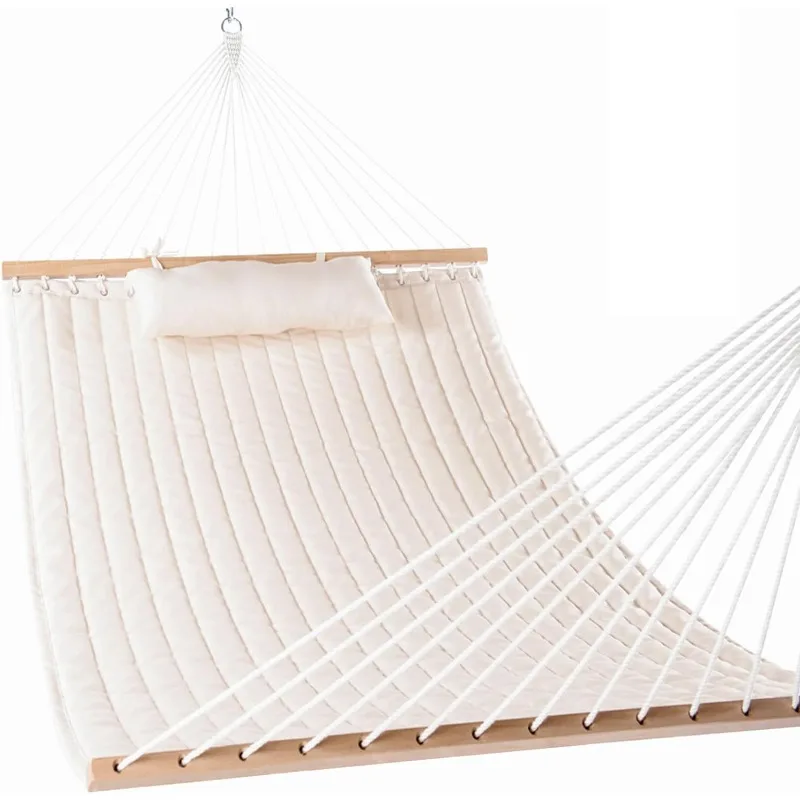
Weather Resistance: Protecting Your Hammock Investment
Outdoor hammocks face constant challenges from weather elements that can quickly degrade inferior fabrics. Selecting materials with appropriate weather resistance extends your hammock’s lifespan and maintains its appearance and functionality.
Water resistance represents a primary concern for outdoor hammocks. While few fabrics are completely waterproof without special treatments, many quality hammock materials offer natural water repellency or can be treated to achieve this property. Water-resistant fabrics prevent immediate saturation during light rain or morning dew, giving you time to move or cover the hammock before damage occurs.
Quick-drying capability matters almost as much as water resistance. Even water-resistant fabrics will eventually become damp in prolonged exposure. Fabrics that dry quickly after becoming wet significantly reduce the risk of mold and mildew growth, which can permanently stain and weaken the material.
UV radiation causes fading and structural breakdown in many fabrics, particularly natural fibers. Quality outdoor hammock fabrics incorporate UV stabilizers or utilize inherently sun-resistant fibers. Solution-dyed acrylics and specially treated polyesters offer excellent UV resistance, maintaining their color and strength despite years of sun exposure.
Understanding the best materials for outdoor hammocks helps you select fabrics that resist all these environmental challenges while maintaining comfort and appearance.
Maintenance Considerations: Keeping Your Quilted Hammock Beautiful
The ease of maintaining your quilted hammock directly impacts both its lifespan and your ongoing satisfaction. Different fabrics require vastly different cleaning approaches and frequency of care.
Stain resistance varies dramatically between fabric types. Synthetic fabrics like polyester and solution-dyed acrylic naturally resist staining and can often be cleaned with simple soap and water. Cotton, while comfortable, absorbs stains more readily and may require more intensive cleaning methods.
Cleaning requirements depend on both fabric type and finishing treatments. Some synthetic hammock fabrics can be machine washed, while others require gentle hand washing or spot cleaning only. Following the proper cleaning protocol for your specific fabric prevents premature wear, color fading, and structural damage.
Frequency of maintenance directly correlates with fabric choice. Some premium hammock materials need only occasional cleaning and minimal protection from the elements, while others require regular attention to maintain their appearance and function.
Storage considerations also vary by fabric type. Natural fibers generally need more careful storage in dry environments to prevent mildew, while many synthetics can withstand less ideal storage conditions. Understanding proper hammock installation requirements and safety includes knowing how to properly store your hammock when not in use.
Polyester: The Reliable All-Weather Option
Polyester stands as perhaps the most commonly used fabric for quality quilted hammocks, offering an exceptional balance of performance characteristics at a reasonable price point.
This synthetic fiber delivers outstanding durability, with high tensile strength and excellent resistance to stretching over time. Unlike natural fibers, polyester maintains its structural integrity when wet and resists degradation from UV exposure when properly treated. Its natural resistance to mold, mildew, and rot makes it ideal for humid environments where other fabrics might quickly deteriorate.
| Polyester Pros | Polyester Cons |
|---|---|
| Excellent durability and strength | Less breathable than natural fibers |
| Highly resistant to stretching | Can feel less premium than some alternatives |
| Good UV resistance when treated | Petroleum-based (environmental concerns) |
| Quick-drying properties | Can generate static electricity |
| Holds color well | May pill over time with heavy use |
| Affordable price point |
For quilted applications specifically, polyester excels at holding batting in place while maintaining even quilting patterns. Its resistance to shifting makes it ideal for maintaining the hammock’s intended design and comfort. Our quilted fabric hammock sets feature high-performance polyester that delivers years of reliable service while maintaining its attractive appearance.
Solution-Dyed Acrylic: Premium Outdoor Performance
Solution-dyed acrylic represents the gold standard for premium outdoor hammock fabrics, offering unmatched performance for exposed outdoor locations.
The solution-dyeing process fundamentally differentiates this fabric from others. Rather than dyeing the finished fabric, the color is added to the liquid acrylic solution before the fibers are created. This means the color permeates the entire fiber rather than just coating the surface, resulting in exceptional colorfastness even after years of intense sun exposure.
| Solution-Dyed Acrylic Pros | Solution-Dyed Acrylic Cons |
|---|---|
| Superior UV and fade resistance | Premium price point |
| Excellent water repellency | Less stretchy than some alternatives |
| Mildew and mold resistant | Can feel stiffer initially than natural fibers |
| Highly durable (5+ year lifespan) | May require professional cleaning for deep stains |
| Breathable despite water resistance | Heavier than some alternatives |
Unlike many synthetic fabrics, quality acrylic offers a soft, cotton-like feel that improves with age and use. This combination of comfort and performance makes it ideal for creating long-lasting outdoor quilted hammocks that maintain their appearance despite exposure to harsh elements.
For hammocks intended for premium outdoor living spaces, our various fabric hammock sets include solution-dyed acrylic options that deliver unmatched performance and longevity.
Olefin: Lightweight Strength and Stain Resistance
Olefin (polypropylene) offers a compelling alternative for quilted hammocks, particularly for those concerned about stains and chemical exposure. This synthetic fabric delivers exceptional stain resistance while maintaining good strength characteristics.
What truly distinguishes olefin is its resistance to chemicals, oils, and stains. Unlike most fabrics that absorb spills, olefin naturally repels liquids, allowing them to be wiped away before staining occurs. This makes it particularly suitable for hammocks used during meals or in environments where spills are likely.
| Olefin Pros | Olefin Cons |
|---|---|
| Superior stain and chemical resistance | Less UV resistant than acrylic |
| Extremely lightweight | Can flatten with heavy use |
| Naturally water-resistant | Limited color options |
| Quick-drying properties | Not as soft as cotton or acrylic |
| Environmentally friendly production | Can generate static electricity |
Despite its impressive strength-to-weight ratio, olefin does have limitations regarding UV exposure. Without proper stabilizers, it can degrade more quickly than other synthetics when exposed to intense sunlight. However, modern treatments have significantly improved its UV resistance, making it suitable for semi-protected outdoor locations.
For quilted hammocks, olefin’s lightweight nature makes it an excellent choice when portable or lighter-weight options are desired.
Cotton: Natural Comfort for Protected Environments
Cotton remains the traditional choice for quilted hammocks, offering unmatched natural comfort and breathability. This natural fiber creates a soft, breathable surface that feels pleasant against bare skin and naturally regulates temperature.
Several cotton varieties and weaves serve different hammock applications. Canvas and duck cotton provide exceptional durability through tight weaving patterns and heavier weights (typically 7-10 oz/square yard for hammocks). Lighter cotton fabrics offer enhanced breathability but sacrifice some durability and weather resistance.
| Cotton Pros | Cotton Cons |
|---|---|
| Superior natural comfort | Poor weather resistance |
| Excellent breathability | Susceptible to mold and mildew |
| Biodegradable material | Shrinks when wet |
| Improves with washing | Fades with UV exposure |
| Authentic traditional appeal | Requires more maintenance |
Cotton’s primary limitation is its vulnerability to weather elements. Without protective treatments, cotton readily absorbs moisture, potentially leading to mildew growth, rot, and structural weakening. Additionally, untreated cotton can shrink when wet and stretch with use, potentially distorting the hammock’s shape over time.
For indoor use or well-protected outdoor spaces, cotton creates wonderfully comfortable quilted hammocks. Understanding the guide to choosing outdoor fabric hammocks helps determine whether cotton suits your specific environment.
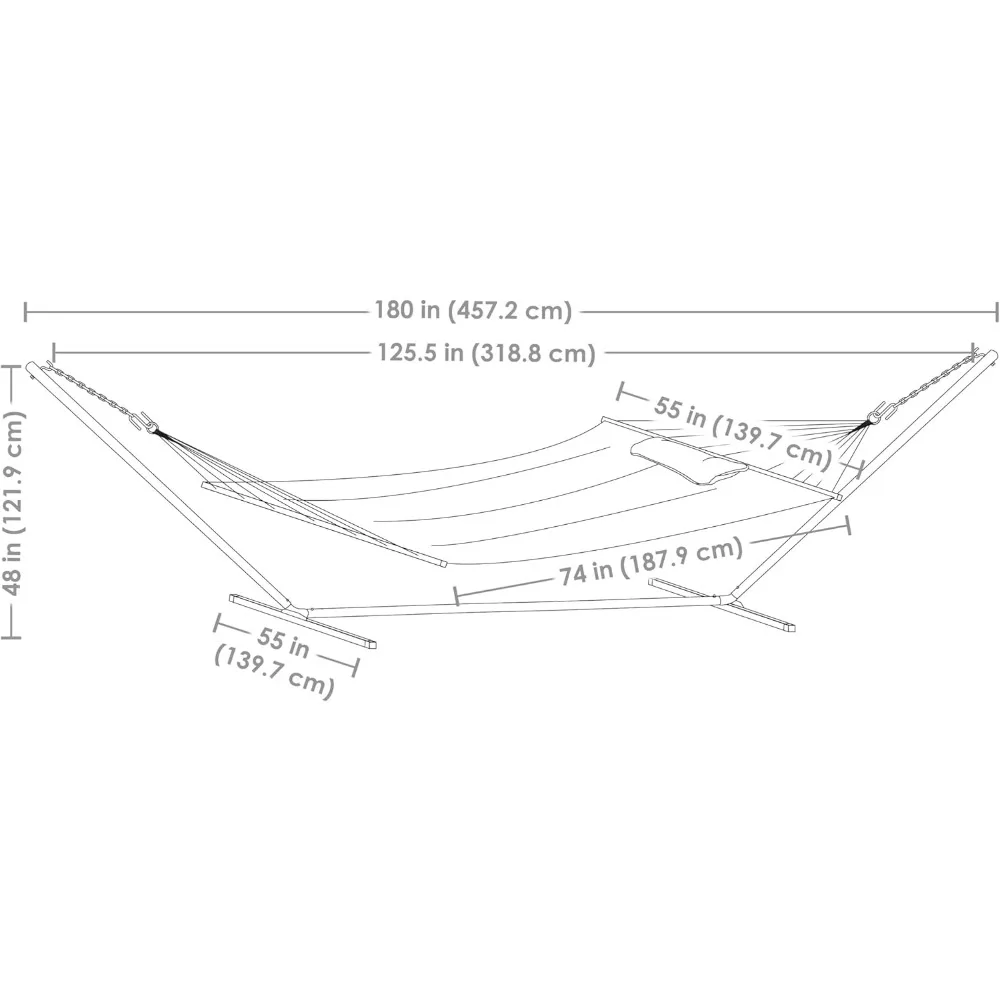
Nylon: Strength-to-Weight Champion
Nylon stands as the unrivaled champion in strength-to-weight ratio among hammock fabrics. This synthetic material delivers remarkable tensile strength while remaining lightweight and packable.
Originally developed as a silk alternative, nylon shares some of silk’s smooth feel while offering vastly superior durability. Its exceptional tensile strength allows it to support substantial weight with relatively thin material, making it ideal for travel hammocks and applications where weight matters.
| Nylon Pros | Nylon Cons |
|---|---|
| Outstanding strength-to-weight ratio | Less comfortable against skin than cotton |
| Highly resistant to abrasion | Can feel clammy in humid conditions |
| Quick-drying properties | May create static electricity |
| Excellent tear resistance | Degrades with prolonged UV exposure |
| Lightweight and packable | Less breathable than natural fibers |
For quilted applications, nylon provides excellent structural support while adding minimal weight. This makes it particularly valuable for quilted hammocks intended for camping or travel, where every ounce matters. Our spreader bar hammock sets sometimes incorporate nylon components to balance comfort with necessary strength.
While not as naturally comfortable against skin as cotton, nylon’s performance characteristics make it worth considering, particularly for hammocks that will see adventurous use.
Fabric Blends: The Best of Both Worlds
Fabric blends combine different fibers to create materials that capture the best qualities of each while mitigating their weaknesses. These engineered fabrics often deliver superior overall performance compared to single-fiber options.
Poly-cotton blends represent the most common hammock fabric combination, typically featuring 65% polyester and 35% cotton. This ratio provides a good balance of polyester’s durability and weather resistance with cotton’s natural comfort and breathability. The resulting fabric feels softer than pure polyester while offering better weather resistance than pure cotton.
Other valuable blends include:
- Acrylic-polyester blends: Combining acrylic’s UV resistance with polyester’s strength
- Cotton-nylon blends: Enhancing cotton’s durability while maintaining most of its comfort
- Olefin-polyester blends: Adding stain resistance to polyester’s overall durability
The ideal blend depends on your specific priorities and usage environment. For quilted hammocks specifically, blends can help maintain the quilting pattern’s integrity while still providing the comfort expected from a premium relaxation product.
Classic Wooden Stand Hammock Sets, Heavy Duty Hammock Sets
$1,061.68 Select options This product has multiple variants. The options may be chosen on the product pageHammock Sets with Canopy, Heavy Duty Hammock Sets
$286.31 Select options This product has multiple variants. The options may be chosen on the product pageHeavy Duty Hammock Sets, Wooden Arc Stand Hammock Sets
$878.66 Select options This product has multiple variants. The options may be chosen on the product page- $270.16 Select options This product has multiple variants. The options may be chosen on the product page
Inner Batting and Filling: Completing Your Quilted Hammock
The fabric discussion isn’t complete without addressing the inner batting or filling that creates the distinctive comfort of quilted hammocks. This hidden component works in concert with the outer fabric to determine the hammock’s overall feel and performance.
Polyester batting dominates the quilted hammock market due to its balance of loft, resilience, and moisture resistance. Unlike cotton batting, polyester resists compression over time, helping the hammock maintain its cushioned feel through years of use. It also dries quickly when wet and resists mold and mildew growth.
| Batting Material | Comfort Level | Weather Resistance | Longevity | Best Use Environment |
|---|---|---|---|---|
| Polyester | Medium-High | Excellent | 5+ years | All environments |
| Cotton | High | Poor | 2-3 years | Indoor/protected only |
| Wool | Very High | Good | 3-4 years | Cool/dry climates |
| Synthetic Down | Very High | Medium | 3-5 years | Indoor/seasonal outdoor |
The thickness of batting significantly impacts both comfort and weather resistance. Thicker batting provides more insulation and cushioning but increases drying time when wet. For year-round outdoor use, moderate batting thickness with quick-drying synthetic materials works best. Indoor hammocks can prioritize thicker, softer batting for maximum comfort.
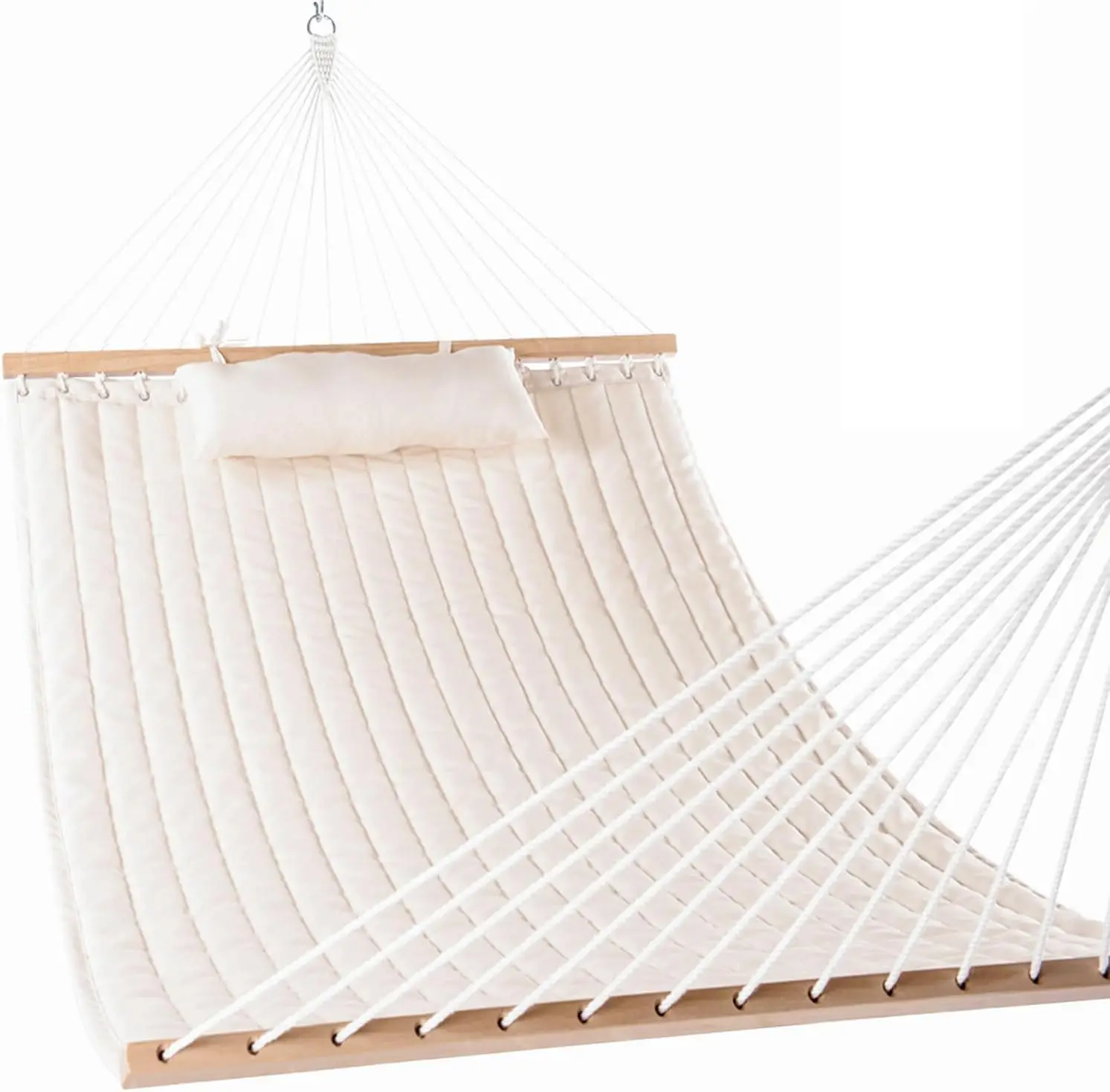
Does Weather Exposure Affect Fabric Selection for Quilted Hammocks?
Yes, weather exposure fundamentally impacts which fabrics will perform best for your quilted hammock. The level of exposure directly determines the appropriate materials for durability and ongoing comfort.
For fully exposed locations—those receiving direct sunlight and rainfall—solution-dyed acrylic and specially treated polyester offer the best performance. These materials resist UV degradation, dry quickly after rain, and maintain their structural integrity despite temperature fluctuations.
Partially covered environments like porches or areas under tree canopies can successfully use standard polyester, olefin, or poly-cotton blends. These locations benefit from some protection while still requiring good weather resistance for occasional exposure.
Seasonal considerations also matter significantly. Hammocks used primarily in summer may prioritize breathability and quick-drying properties, while those intended for year-round use need better resistance to temperature extremes and potential snow or ice exposure. Finding the perfect hammock placement for your home or garden helps determine exactly how much weather protection your hammock requires.
How Should You Clean Different Quilted Hammock Fabrics?
Proper cleaning extends your hammock’s life while maintaining its appearance and comfort. Each fabric type requires specific approaches:
For polyester and nylon hammocks:
* Brush off loose dirt and debris regularly
* Spot clean stains with mild soap and water
* For deeper cleaning, hand wash in lukewarm water with gentle detergent
* Rinse thoroughly to remove all soap residue
* Air dry completely before storage or use
For cotton and cotton-blend hammocks:
* Vacuum or brush off surface dirt weekly
* Treat stains immediately with gentle soap
* Hand wash or use delicate machine cycle with cold water
* Avoid bleach or harsh cleaners
* Air dry to prevent shrinkage
For solution-dyed acrylic:
* Rinse regularly with fresh water to prevent dirt buildup
* Clean spills promptly with mild soap and soft brush
* For deeper cleaning, use specialized fabric cleaners
* Rinse thoroughly and allow to air dry
* Never use pressure washers or harsh chemicals
All fabric types benefit from preventative maintenance. Simply brushing off leaves, pollen, and dirt before they become embedded in the fabric significantly reduces cleaning frequency and extends the hammock’s life.
Are Synthetic Fabrics Always Better Than Natural Fabrics for Quilted Hammocks?
No, synthetic fabrics aren’t universally superior—the best choice depends entirely on your specific needs and usage environment.
Natural fabrics like cotton excel in comfort, breathability, and environmental sustainability. For indoor use or well-protected outdoor spaces like screened porches, cotton creates an unmatched relaxation experience. Its soft texture and excellent temperature regulation make it ideal for direct skin contact, and many users appreciate its natural origin and biodegradability.
Synthetics clearly dominate in weather resistance, maintenance requirements, and longevity in challenging environments. For hammocks facing full weather exposure or needing maximum durability, materials like solution-dyed acrylic and high-performance polyester simply outperform natural alternatives.
Environmental considerations also matter. While synthetic production typically consumes more resources initially, the longer lifespan of these products can actually reduce overall environmental impact compared to frequently replacing degraded natural fiber hammocks.
The ideal approach often involves selecting the right material for each specific use case rather than assuming one fabric category is universally superior.
Is it Possible to Create a Year-Round Outdoor Quilted Hammock?
Yes, creating a truly year-round outdoor quilted hammock is achievable with proper material selection and care routines.
For maximum durability in continuous outdoor exposure, the ideal fabric combination includes:
- Solution-dyed acrylic outer fabric for unmatched UV and weather resistance
- Synthetic water-resistant batting that maintains loft when wet
- Multi-filament polyester thread for quilting that resists UV degradation
- Reinforced attachment points using marine-grade hardware
Even with these optimal materials, protective measures significantly extend hammock life. Using a weather-resistant cover during extended periods of non-use prevents unnecessary exposure. Removing accumulated snow, ice, or standing water prevents material stress and potential mold growth.
With high-quality materials and reasonable care, a premium quilted hammock can provide 5-10 years of reliable outdoor service, transforming your outdoor space into a year-round relaxation destination.

